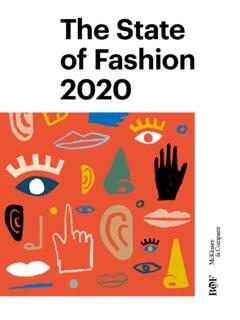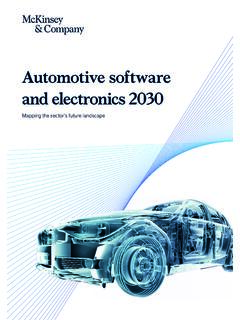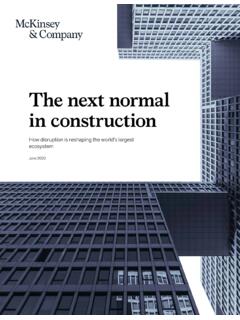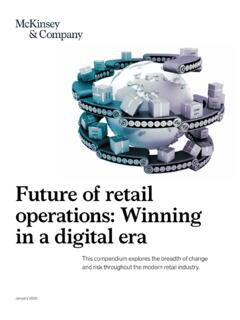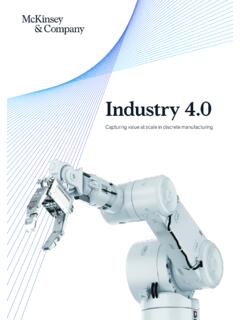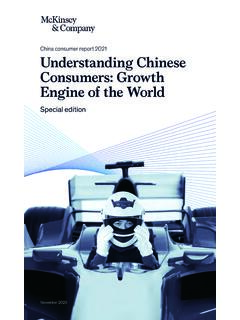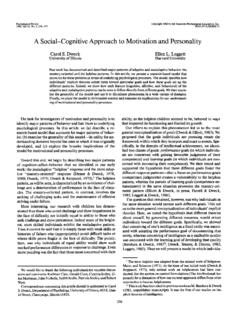Transcription of China and the world - McKinsey & Company
1 July 2019 China and the world : Inside the dynamics of a changing relationshipChina and the worldInside the dynamics of a changing relationship McKinsey Global InstituteSince its founding in 1990, the McKinsey Global Institute (MGI) has sought to develop a deeper understanding of the evolving global economy. As the business and economics research arm of McKinsey & Company , MGI aims to provide leaders in the commercial, public, and social sectors with the facts and insights on which to base management and policy decisions. MGI research combines the disciplines of economics and management, employing the analytical tools of economics with the insights of business leaders. Our micro-to-macro methodology examines microeconomic industry trends to better understand the broad macroeconomic forces affecting business strategy and public policy.
2 MGI s in-depth reports have covered more than 20 countries and 30 industries. Current research focuses on six themes: productivity and growth, natural resources, labor markets, the evolution of global financial markets, the economic impact of technology and innovation, and urbanization. Recent reports have assessed the digital economy, the impact of AI and automation on employment, income inequality, the productivity puzzle, the economic benefits of tackling gender inequality, a new era of global competition, Chinese innovation, and digital and financial is led by three McKinsey & Company senior partners: Jacques Bughin, Jonathan Woetzel, and James Manyika, who also serves as the chairman of MGI. Michael Chui, Susan Lund, Anu Madgavkar, Jan Mischke, Sree Ramaswamy, and Jaana Remes are MGI partners, and Mekala Krishnan and Jeongmin Seong are MGI senior teams are led by the MGI partners and a group of senior fellows and include consultants from McKinsey offices around the world .
3 These teams draw on McKinsey s global network of partners and industry and management experts. The MGI Council, which includes leaders from McKinsey offices around the world and the firm s sector practices, includes Michael Birshan, Andr s Cadena, Sandrine Devillard, Andr Dua, Kweilin Ellingrud, Tarek Elmasry, Katy George, Rajat Gupta, Eric Hazan, Acha Leke, Scott Nyquist, Gary Pinkus, Sven Smit, Oliver Tonby, and Eckart Windhagen. In addition, leading economists, including Nobel laureates, advise MGI partners of McKinsey fund MGI s research; it is not commissioned by any business, government, or other institution. For further information about MGI and to download reports, please visit and the world : Inside the dynamics of a changing relationshipChina and the world : Inside the dynamics of a changing relationship AuthorsJonathan Woetzel, ShanghaiJeongmin Seong, ShanghaiNick Leung, Hong KongJoe Ngai, Hong KongJames Manyika, San FranciscoAnu Madgavkar, MumbaiSusan Lund, Washington, DCAndrey Mironenko, SydneyJuly 2019iiiChina and the world : Inside the dynamics of a changing relationshipThe relationship between China and the rest of the world appears to be entering a new phase.
4 China s economic miracle was fueled by industry and investment, but today domestic consumption is the main driving force of growth. The country is becoming less exposed in economic terms to the rest of the world . However, reflecting China s rise to being the world s second-largest economy and its leading trading nation, the rest of the world is becoming more exposed to China . These shifts have been accompanied by trade tensions and rising protectionism in many countries, raising the question whether we have reached a point of peak integration between China and the world . In this report, we look at the extent of China s global scale and integration, and highlight the findings of the new McKinsey Global Institute China - world Exposure Index. We examine the exposure of sectors and countries to the China - world relationship, with particular emphasis on the technology and consumer sectors.
5 Finally, we simulate what value might be at stake for China and the rest of the world from less engagement and from more engagement, and briefly explore how businesses might navigate what may be a highly uncertain environment. This report is part of a series of MGI publications on global trade that includes Digital globalization: The new era of global flows in March 2016 and Globalization in transition: The future of trade and value chains in January research was led by Jonathan Woetzel, a director of MGI based in Shanghai, and Jeongmin Seong, an MGI senior fellow in Shanghai; Nick Leung, McKinsey senior partner and chairman of McKinsey Greater China ; and Joe Ngai, McKinsey senior partner and managing partner of McKinsey Greater China ; James Manyika, chairman and director of MGI in San Francisco; Anu Madgavkar, MGI partner in Mumbai; and Susan Lund, MGI partner in Washington, DC.
6 Andrey Mironeko and James Bien led the research team, which comprised Mo Chen, Carmen Liu, Meng Meng, Raye Qin, Erik Rong, Ben Wang, and Minyu Xiao. We are also grateful for the input and guidance of Rik Kirkland, McKinsey partner for global publishing in London; Glenn Leibowitz, McKinsey s group head of external relations in Greater China ; and Ziad Haider, head of risk for McKinsey , Asia. Our academic and external advisers challenged our thinking and added new insights. We extend sincere thanks to Martin Baily, Bernard L. Schwartz Chair in Economic Policy Development and senior fellow and director of the Business and Public Policy Initiative at the Brookings Institution; Gordon Orr, director emeritus and senior adviser to McKinsey ; Dr. Andrew Sheng, distinguished fellow of the Asia Global Institute; and Nicholas R.
7 Lardy, Anthony M. Solomon Senior Fellow at the Peterson Institute for International Economics. We thank the many business leaders, policy makers, and researchers at public and private institutions who shared their insights project benefited immensely from the industry expertise of many McKinsey colleagues. We thank Stefan Burghardt, Albert Chang, Wonsik Choi, Michael Chui, Karel Eloot, Paul Gao, Mingyu Guan, Patrick Hertzke, Sheng Hong, Forest Hou, Richard Huang, Daniel Hui, Mekala Krishnan, Gang Liang, Lan Luan, Katrina Lv, Felix Poh, John Qu, Dennis Schwedhelm, Sha Sha, Yezhou Shi, Antonio Sun, Florian Then, Christopher Thomas, Jin Wang, Ting Wu, Alex You, Cherie Zhang, Derek Zhang, Haimeng Zhang, Susan Zhang, Gaobo Zhou, Tiankai Zhu, and Daniel Zipser.
8 Preface This report was produced by MGI senior editor Janet Bush, editorial production manager Julie Philpot, and senior graphic designers Marisa Carder and Patrick White, with support from Cathy Gui, MGI s head of external relations in Asia Pacific; Lauren Meling, MGI digital editor; and Timothy Beacom, MGI content specialist. This report contributes to MGI s mission to help business and policy leaders understand the forces transforming the global economy and prepare for the next wave of growth. As with all MGI research, this work is independent, reflects our own views, and has not been commissioned by any business, government, or other institution. We welcome your comments on the research at Bughin Director, McKinsey Global Institute Senior partner, McKinsey & Company Brussels James Manyika Director and Chairman, McKinsey Global Institute Senior partner, McKinsey & Company San Francisco Jonathan Woetzel Director, McKinsey Global Institute Senior partner, McKinsey & Company Shanghai July 2019 ContentsIn brief viiiExecutive summary 11.
9 How globally integrated is China ? 252. The relationship between China and the world is changing 453. China s technology value chains are globally integrated 634. China s consumption offers new opportunities for the world 875. The potential value at stake from less and more engagement 1096. Managing through the uncertainty 135 Technical appendix 145 Bibliography 153 China has made progress in integrating with the world economy, achieving true global scale as a trading nation, but not in other areas such as finance. Now the relationship between China and the rest of the world is changing. A great deal of value could be at stake depending on whether there is more or less engagement.
10 Businesses will need to adjust their approach to navigate the uncertainties ahead. China , which became the world s largest economy in purchasing-power-parity terms in 2014, is a global power in scale but not always in global integration. It became the world s largest trading nation of goods in 2013. However, although China has 111 Global Fortune 500 companies, more than 80 percent of their revenue is still earned at home. China s banking, securities, and bond markets rank in the global top three in size, but international players have limited presence. The relationship between China and the world is changing. On the new McKinsey Global Institute China - world Exposure Index, China s exposure to the world in trade, technology, and capital has fallen in relative terms.


